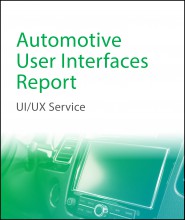AutoTechInsight

Automotive User Interfaces Report
Automotive industry is currently experiencing a trend-shift, wherein OEMs continue to distinguish themselves from competitors, resulting in automotive HMI becoming more and more crucial for OEMs to achieve this goal. Owing to the continuous adoption of advanced technology, user interface will not only be a major distinguishing factor influencing consumer's decision but will also be a core component of the brand’s identity.
In recent years we have seen growing emphasis placed on the role of automotive user interfaces by OEMs, in part they represent a major opportunity to differentiate.
- The market for automotive user interfaces (UIs) is well positioned for growth in sales and revenue, as well as new technological innovations. The industry was once composed of nothing more than buttons and knobs. It now includes speech recognition, touch-screen displays, liquid crystal displays (LCDs), light-emitting diodes (LEDs), organic light-emitting diodes (OLEDs), touch pads, haptic feedback, gesture recognition, and much more.
- Part of the reason the variety of automotive UIs is so vast is the ever-increasing complexity of infotainment. New interaction design is necessary to enable safe operation of these complex systems while driving. Other drivers for new and increasing levels of human machine interface (HMI) technology include safety mandates such as rear cameras, which are influencing OEMs to install as standard displays on vehicles in all segments and classes—from high-end luxury down to the B-segment economy.
About this report
- This report focuses on all major in-vehicle infotainment HMI component both outputs and inputs. The report provides current market volume of HMI components along with forecast numbers.
- While many detailed forecasts are included in the following report, more detailed forecast data are also available in the separate Excel file that accompanies this report.
- This report also discusses the impact of COVID-19 on the automotive UI market by considering change in automotive sales
- Introduction
- Research scope & definitions
- Report revision detail
- Key market drivers
- Center stack displays
- Overview
- Technology share
- Trend & analysis
- Instrument Clusters
- Overview
- Technology share
- Trend & analysis
- Head-up displays
- Overview
- Technology share
- Trend & analysis
- Total primary automotive display systems
- Overview
- Technology share
- Trend & analysis
- Touch screens
- Overview
- Technology share
- Trend & analysis
- Haptics
- Overview
- Technology share
- Trend & analysis
- Gesture Recognition
- Overview
- Technology share
- Trend & analysis
- Interior Controls
- Overview
- Steering Wheel Controls
- Infotainment Control Panels
- HVAC Control Panels
- Multi-Function Controllers
- Trend & analysis
- Speech recognition
- Overview
- Technology share
- Trend & analysis
- Consumer Preferences
- HUDs
- Speech recognition
- Impact of COVID-19
- Overview
- Conclusion
- Conclusion
- Database
- Download





